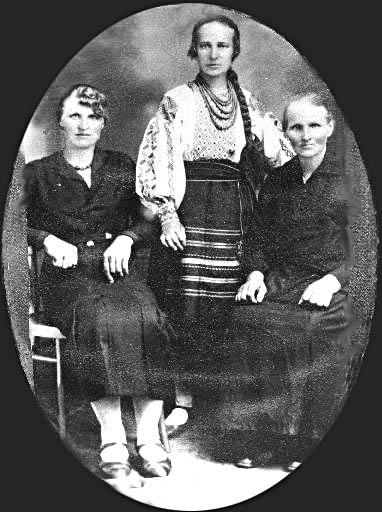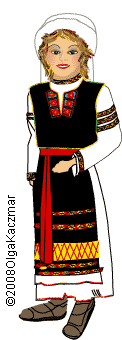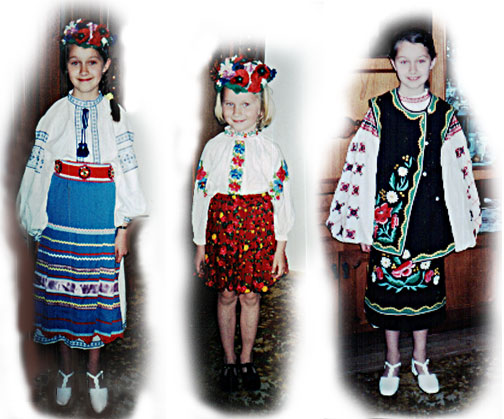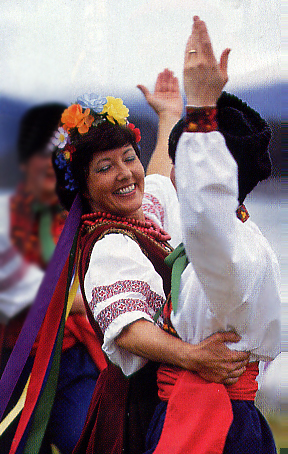For more colorful Lemko maps, see http://www.rollintl.com
The following photos are for
educational purposes and not for profit
Below left: Typical Lemko house with grass roof. This photo is from Shevchenko Grove Museum in the Lemko sector from Zaricheve village in Zakarpatski oblast.
Below right?
Notify us if you know which region this costume is from.
Virginia
To Olga,
An acquaintance of mine, from Ukraine looked at the costume, and told me that it comes from the Mostyskyi
raion in the Lviv oblast. The girl could have been a bridesmaid at a wedding or a dancer. This costume is very old.
Lorne Carpenter
Hello Olha,
The costume pictured
is from Halychyna (Galicia) in the period between the two world wars, probably
from a larger town or city in or around Lviw or east as far as Ternopil. It is
not an "authentic" regional costume. That area experienced an upsurge of Ukrainian
national sentiment in the face of Polish overlordship. They were the most westernised,
and especially in the towns, were mostly wearing western fashions. They still
loved their heritage, and loved to embroider. They would often dress like this
for special occasions, or for Ukrainian cultural activities. The dense blouse
design is typical, and they extended the area embroidered in order to impress.
The narrow apron is basically like a rushnyk. They did three rows of embroidery instead of the traditional one row. The many colors used is a result of DMC embroidery thread entering the market, so many colors to choose from! The macrame and fringe on the bottom edge of the apron is also typical of this era. I can't tell where the ribbons are attached, but they are store bought. The large number of glass beads, however, is also found in the costumes of the Ternopil area. Roman Kozak Thank you for providing an interesting place on the web. Feel free to email; I have a lot of material on folk costumes, esp Ukrainian.
Hi Olya,
Enjoyed looking thru this page. On the photo #1, you ask "where this costume is from?"
Altho the photo seems to be hand-colored after photo was taken, rather than
an actual color-photo, the design of the embroidery on the sleeves, its
arrangement and even the colorist's attempt to give an 'impression' of the
way it appeared to an untutored eye, as well as the total costume effect with
the heavily fringed bottom edge and horizontal bands on the apron -- all this made me think "Sokalshchyna" (due
north of L'viv, still in the L'viv Oblast').
Lorne Carpenter's acquaintance from Ukraine is probably "right on", and it could be from the area of Mosty city, which is due south of Sokal' (Sokalshchyna ethno-area) and half-way on main road to City of L'viv. I have seen two similar shirts with such heavily and multicolor-filled geometrically embroidered sleeves. Both were definitely said to be from the general area of Sokalshchyna. Those sleeves had the effect of stain-glass windows! and this old hand-colored photo strongly resembles them. If you have the Ukr'n Museum of NYC's catalog from the exhibit of pani Kashubins'ka's collection from Uhriniv of the Sokal' area, you can see a few items in it that could help you see how much alike they, and this costume and its parts, appear. This is also very near the area known as "Pidliashshya" (or Podliashia (sp?)), just west of what is called "Polesia" ("Polissia", in Ukr'n), but is not on that territory.
The shoes and the hand-coloration on this image seem to say "mid-1920's", but maybe as late as mid-1930's. It was surely a studio were this photo was taken. I'm certain the coloration on the photo gives a poor interpretation of the actual costume and its colors (including the apron and ribbons), but it's great that you have shown this photo! Thanks for sharing it with us. Tania D.O.
2.) Olga's illustration on the right,
shows a
Lemko women dressed in a chemise, a skirt, a kind of apron, an embroidered vest and, in winter, a sheepskin jacket. They wore a hood or very embroidered babushka and leather footwear (kierptsy) or boots (choboty).
3.) photo by Sergei Mikhailovich
Malo Rosii (Little Russia - meaning Rusyn) Lot 10333
Typical costume: babushka, puffy sleeved embroidered blouse, long warm vest, long skirt and apron. Apron looks to be heavily embroidered. She wears a babushka on her head which may be embroidered also.
4.) Pani Olyu,
By the design on the front of the blouse, it looks like it is from the Poltavska oblast. The design on the sleeves is not very clear. I could not distinguish the sleeves very much, but the front panel of the shirt just hit me when I saw it.
The reason why I think it is a Poltavskyi design it is because it resembles very much the Reshetylivka embroidery style presently popular in Ukraina. Reshetylivka is a small town about 60 kms from Poltava famous for its embroidery school and it used to be famous for its big embroidery plant during the Soviet years.
Lada
It's not a full costume, central Ukraine or eastern Podillia maybe, judging by the cut of the sleeves of the shirt (with the vustavka). The apron is woven, but that could be in a few regions. Lovely faces.
This is not an old traditional sorochka(shirt), unless it's from a very particular place. Women's shirts rarely if at all had embroidery on the bodice - esp. as much as this shirt. This has more than enough for a man's shirt, since women wore a large namysto (necklace), usually coral, and a kersetka (the sleeveless long fitted "jacket") over the shirt, there was no point to do all that embroidery just to have it covered up.
In Ukrains'kyi Narodnyi Odiah/Ukrainian Folk Costume (Toronto / Philadelphia: SFUZHO, 1992), there are a few sorochky with similar sleeves (not bodices) - from the regions of Poltava, Chernihiv, Kharkiv...
Not only the embroidery, stitches, and colours are important -- the CUT of the shirt is regional also. and this one fits with these areas. Except for the embroidery on the front.
This could be a photo from the beginnning of this century. Maybe this is a pieced shirt, from two others, or just one the person wanted to make this way.
I forwarded the photo to a friend in Yuzhny, which is located up the coast
from Odessa. She and her mother could not determine the location for certain, because it was not a color photo. The mother speculated it might be from western Ukraine, but needed to see the colors to be certain. more info is needed, but -- based on the outfit -- not western Ukraine.
Orysia
Hello Orysia,
You're right that is not a full costume. The coat is missing. I would guess Transcarpathian, Hutzul or even Lemko. With the poyas (belt) and the shoes I would lean toward Hutzul. With the beads and the blouse probably not Bukovina but
more Halychyna region. With the long braid (or kossa) she is probably single.
Bill E.
Hi, Olga
5.) The girls probably belong to some dance school, right? The black stockings and white shoes?!?!?!? Anyway, sort of attempts at a costume, but....... And not fair to judge, since people try their best and mean well, and do what they can with what they can and what they know.
The first outfit is sort of central Ukraine (Kyiv region); the second one, no real place. Blue is NOT traditional as a solitary embroidery colour. Touches of blue appear in S.W. Ukraine (Zakarpattia, some Hutsul, Boyko areas) but not alone.
The embroidery on the last shirt is who knows from where? No such traditional embroidery. The skirt is the typical shalianova / challis skirt for girls
Orysia
The ribbons/stripes on the first apron look very Lemko-style. Olga
6.) Men wore black hats while women sported embroidered kerchiefs; both wore embroidered vests and white shirts with colorful hand cross stitching.
7.)
Three native Carpathian and Ukrainian male costumes, painting by A. Vacuna.
8.) Ukrainian costumes (left) and
9.) Hutsul & Carpathian costumes (right) 1989 by A M Trubnukov
10.) Carpathian vest, possibly Hutsul, worn by male on right. The Hutsuls are very big on orange in their embroidery and weaving.
11.) Kozak costume (blue wide pants with red sash) worn by male on left. The shirt front will be embroidered for festive events.
12.) Ukrainian costume worn by female
13.) Ukrainian dance ensemble from Kiev in Los Angeles 2001
14.) Ukrainian dance ensemble in Los Angeles 1989
15.) Ukrainian dance at UCLA, Los Angeles 1988
I
enjoyed coming upon your website and thought you might be interested
in the attached photo of my mother (the little blond girl) and her family
(sister, brothers and mother) taken in Plonna, Poland in 1930. It gives
you a picture of everyday clothing of a poor Lemko family in this region.
Gail [email protected]
18. Judith Hrynenko [email protected] sends us a Hutsul costume and poem:
Just the other day I received a Ukrainian Christmas card from the Ukrainian Canadian Congress...The cover image was designed by Nadia Starovolova, printed in Canada.
Proud To Be Ukrainian
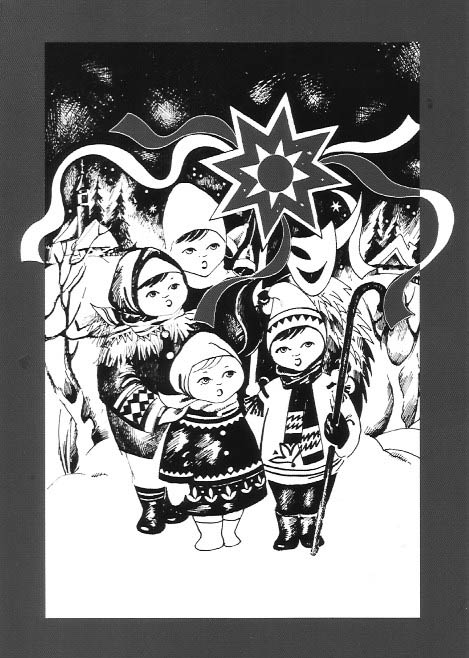 With dreams of freedom and a better life
they set aside their fears. With a sad farewell to their homeland, each brave soul wiped away their tears
And set forth across the sea to a brand new start
Facing endless hardships along the way
Finally, at journey's end, they settled on the prairies
and with each weary day
They build homes, planted crops, and their culture
became and important part
Of their history and the future, as they proudly
carry their Ukrainian heritage within their heart
With dreams of freedom and a better life
they set aside their fears. With a sad farewell to their homeland, each brave soul wiped away their tears
And set forth across the sea to a brand new start
Facing endless hardships along the way
Finally, at journey's end, they settled on the prairies
and with each weary day
They build homes, planted crops, and their culture
became and important part
Of their history and the future, as they proudly
carry their Ukrainian heritage within their heart
Written
by: J. Hinkle
This is a wonder graphic of 'Children Carolers' by Erica Slutsky
Ethnic Rights in Poland
"Poland's parliament on November 4, 2004 passed the National and Ethnic Minorities
Bill that explicitly outlines the status of the country's minority peoples, including
Lemkos. The bill lists by name all of the recognized ethnic and national minorities
that reside in Poland."
Definitions:
Ethnic - those lacking a state such as Roma, Tatars and Lemkos; and
Nationals - a community that has lived in Poland for at least 100 years and is part of a nation that has its own state (including Ukrainians, Slovaks, Germans, Jews, Lithuanians and others. "The bill secures the rights of both national and ethnic minorities to: • access the public media; • state support for minority cultures and languages; • education in minority languages; • use the original spelling of personal names; and • to have bilingual place names in municipalities where the minority group is present in significant number." Quote from the New Rusyn Times, Pittsburgh, PA. Nov/Dec. 2004, Vol 11, Number 6
Click here for more information on:
From Lemko Cultural Past in Dukla Region Journal_file\volume1\number3\6.pdf
Lemko garments http://www.lemko.org
Highlanders of Eastern Beskidy http://www.zb.eco.pl
Lemko costume from town of Vyslok (Wislok) in Lemkivshchyna http://www.lemko.org
Traditional Ukrainian dress http://pages.prodigy.net .....museums
and photo http://pages.prodigy.net/
Dance
company and costume links http://www.desna.icomm.ca/
Valentino fashions featured Ukrainian-style embroidery in 2015 - very beautiful
http://rukotvory.com.ua




